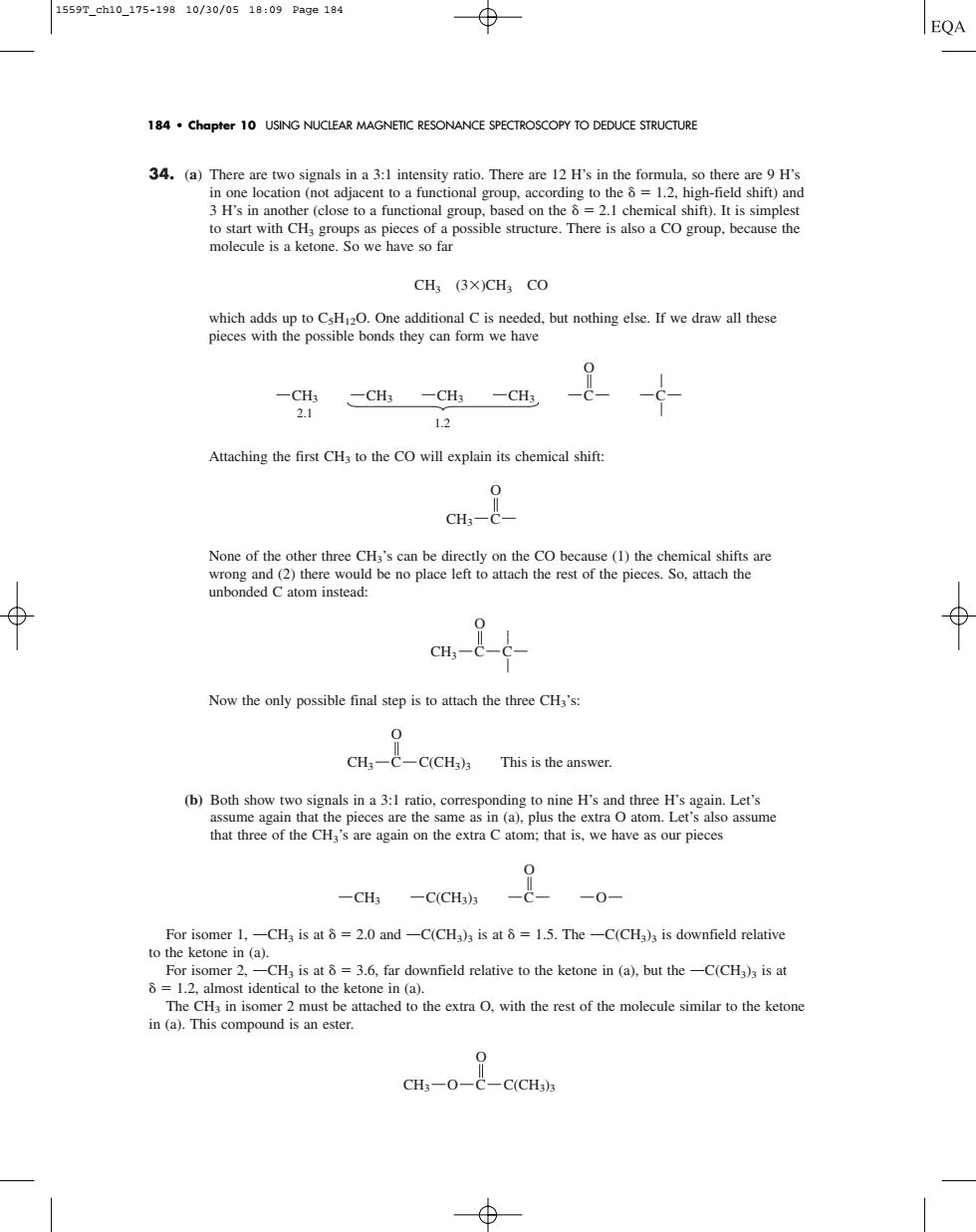正在加载图片...

1559T_ch10_175-19810/30/0518:09Pa9e184 EQA 184.Chapter 10 USING NUCLEAR MAGNETIC RESONANCE SPECTROSCOPY TO DEDUCE STRUCTURE 3H'sin another (functional group,based on the2.1 chemical shift).It is simples CH3(3×)CH,Co which adds up to CHO.One additional C is needed.but nothing else.If we draw all these pieces with the possible bonds they can form we have -CH3-CH3-CH3 -c- 1.2 Attaching the first CH,to the CO will explain its chemical shift None of the other three CH's can be directly on the CO because(1)the chemical shifts are Now the only possible final step is to attach the three CH,'s: 0 CH-c-C(CH)s This is the answer (b)Both show twe ing to nine H's and thre that three of the CHa's are again on the extra C atom:that is.we have as our pieces 一C(CH -0 For isomer 1.-CH,is at 8=2.0 and-C(CH)is at 8=1.5.The-C(CHa)is downfield relative to the ketone in (a). The CH in isomer2 must be attached to the extra with the rest of the molecule similar to the ketone in(a).This compound is an ester. CH-0-C-C(CH2) 34. (a) There are two signals in a 3:1 intensity ratio. There are 12 H’s in the formula, so there are 9 H’s in one location (not adjacent to a functional group, according to the 1.2, high-field shift) and 3 H’s in another (close to a functional group, based on the 2.1 chemical shift). It is simplest to start with CH3 groups as pieces of a possible structure. There is also a CO group, because the molecule is a ketone. So we have so far CH3 (3
)CH3 CO which adds up to C5H12O. One additional C is needed, but nothing else. If we draw all these pieces with the possible bonds they can form we have Attaching the first CH3 to the CO will explain its chemical shift: None of the other three CH3’s can be directly on the CO because (1) the chemical shifts are wrong and (2) there would be no place left to attach the rest of the pieces. So, attach the unbonded C atom instead: Now the only possible final step is to attach the three CH3’s: (b) Both show two signals in a 3:1 ratio, corresponding to nine H’s and three H’s again. Let’s assume again that the pieces are the same as in (a), plus the extra O atom. Let’s also assume that three of the CH3’s are again on the extra C atom; that is, we have as our pieces For isomer 1, OCH3 is at 2.0 and OC(CH3)3 is at 1.5. The OC(CH3)3 is downfield relative to the ketone in (a). For isomer 2, OCH3 is at 3.6, far downfield relative to the ketone in (a), but the OC(CH3)3 is at 1.2, almost identical to the ketone in (a). The CH3 in isomer 2 must be attached to the extra O, with the rest of the molecule similar to the ketone in (a). This compound is an ester. CH3 O O C C(CH3)3 CH3 C(CH3)3 O O C CH3 O C C(CH3)3 This is the answer. CH3 O C C CH3 O C CH3 2.1 1.2 CH3 CH3 CH3 C O C 184 • Chapter 10 USING NUCLEAR MAGNETIC RESONANCE SPECTROSCOPY TO DEDUCE STRUCTURE 1559T_ch10_175-198 10/30/05 18:09 Page 184������